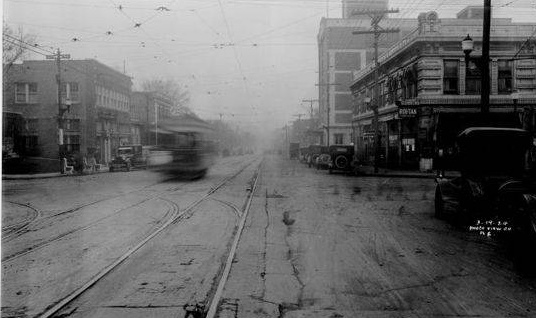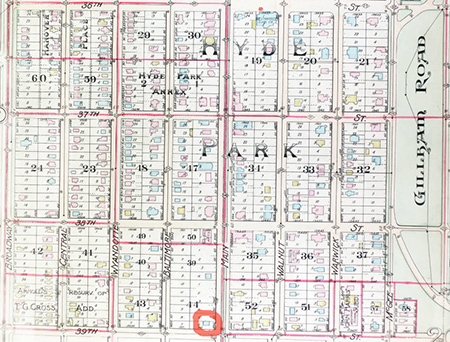
When this 1924 photo of 39th and Main Street was taken, both sides of Main (seen here from the south) had been transformed from open space with a few scattered homes to commercial buildings. The streetcar track offers an important clue to why this change was taking place; getting to and from downtown had become easier, opening up new development in the south side “suburbs.”
When Barbara Bescher bought a lot at the corner of 39th and Main in 1901, the home she built for herself was practically the only thing on the block. But just two decades later, in 1924, the savvy businesswoman sold the property for more than 20 times what she paid for it. The property she purchased for $3000 sold for $70,000 – a sign of how important Thirty-Ninth and Main had become as a commercial corner.

This 1907 Tuttle and Pike map shows the growing Hyde Park area, with Bescher’s home (circled in red) standing in what would prove to be a strategic location at 39th and Main.
As part of our Uncovering History Project, the Midtown KC Post is taking a look at the 1940 tax assessment photos of each block in Midtown. (Many people seem confused by the tax assessment photos, which all include a man holding a sign. Here’s the story behind them). This week, we begin to document what is known about the block between 38th and 39th, from Main to Baltimore. The rest of the block will be featured in upcoming posts. Today, the northeast corner of 39th and Main.
Still undeveloped in 1907
Although much of the area known as Hyde Park or the South Side had been developed in the prior two decades, the northeast corner of 39th and Main held one house in 1907, and the entire block only had two homes.
The entire block had once been part of the “Mastin tract,” a large holding belonging to the Mastin family, who had large holdings in this area before development began. In 1901, the Mastins sold the property to Mrs. Barbara Bescher, an Austrian immigrant with a keen sense of real estate.
Bescher had gone from rags to riches after her divorce in 1896 left her responsible for the support of seven children. Bescher opened a stall at the city market and later bought land at Linwood and Baltimore and built Drexel Hall.
Main Street Homes Give Way to Commercial Business
 By 1924, Bescher’s instincts about the property had paid off. C.H. Price, president of the Linwood State Bank and the owner of a chain of confectionary stores in Kansas City and several other cities, offered her $70,000 for the corner. One of Price’s candy stores was on the same block of Main Street, and he built a two-story building on the corner after Bescher’s home was razed in 1925.
By 1924, Bescher’s instincts about the property had paid off. C.H. Price, president of the Linwood State Bank and the owner of a chain of confectionary stores in Kansas City and several other cities, offered her $70,000 for the corner. One of Price’s candy stores was on the same block of Main Street, and he built a two-story building on the corner after Bescher’s home was razed in 1925.
The building has seen a number of uses over the years, with ground floor retail and second-story office spaces. In the 1980s, the well-known Foolkiller bought the building and offered open mics, concerts and discussions groups.
Do you have memories or more details about this area of Midtown? Please share them with our readers. Would you like us to focus on your block next week? Send us an email.
Our book, Kansas City’s Historic Midtown Neighborhoods, is available now. Let us know if you want us to come to your neighborhood association or organization’s meeting to share what we’ve learned about Midtown neighborhood history and tell your members how they can help preserve Midtown history. If you’d like to order the book, email Mary Jo Draper at mjdraper@midtownkcpost.com.




Trackbacks